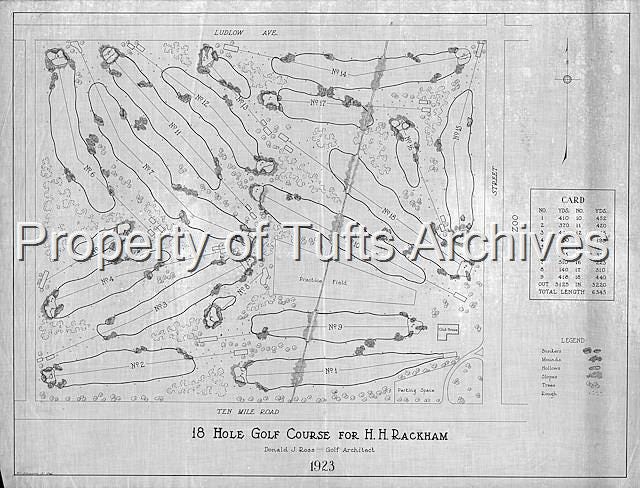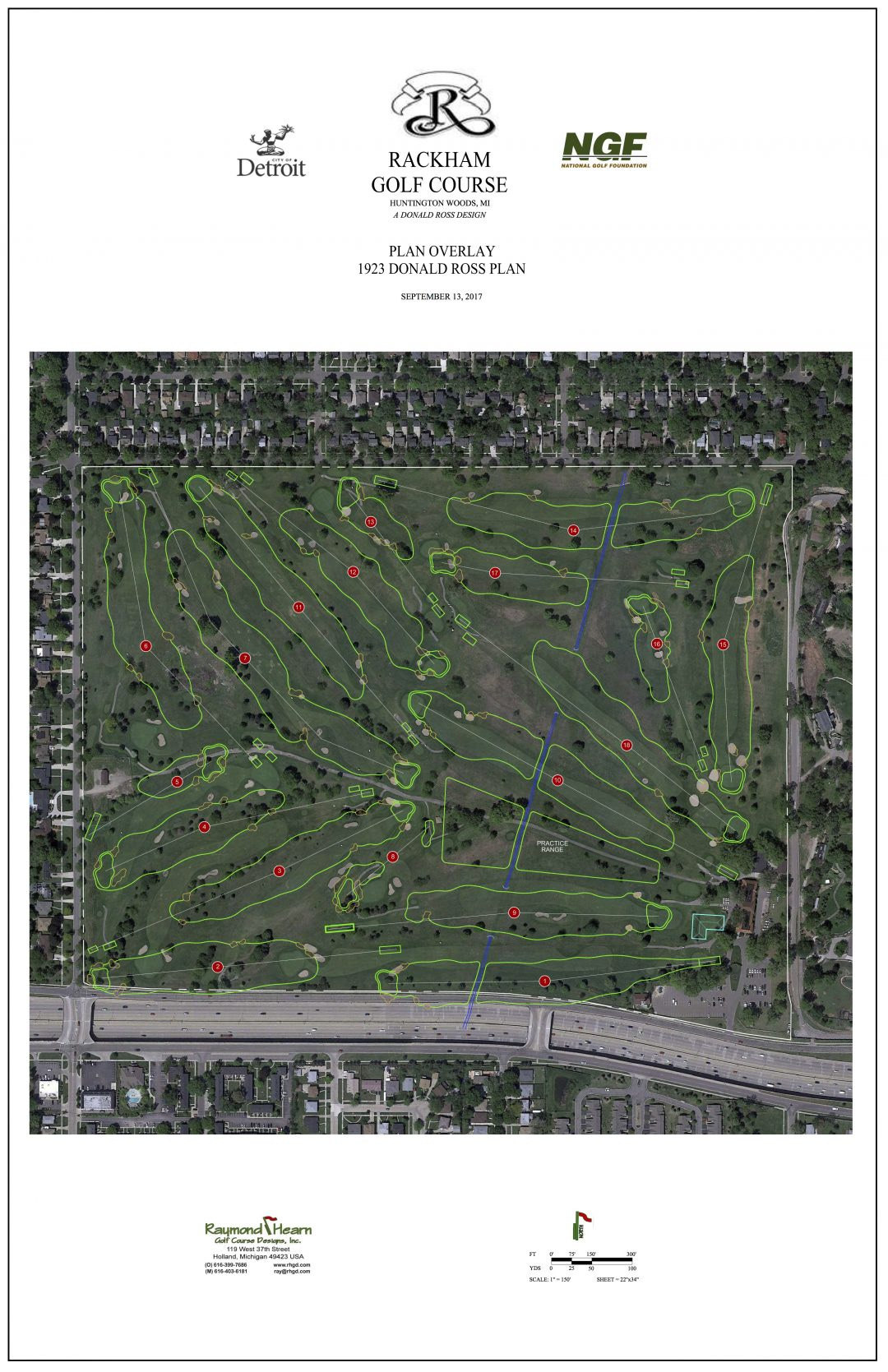This is part one of what I think will be a fairly deep series on city golf in Detroit. I have an end goal in mind with this feature, but it would be premature to talk about it at the moment. For now, while I’m still deep in the fact-finding stage, I’ll present this first segment, which is a look at the routing history of Rackham GC. There is a video companion to this piece embedded below.
GLL Hats
A few weeks ago I opened the Great Lakes Loops store at greatlakesloops.com. I’ve managed to move a few units so far, and feel proud to say that I haven’t fumbled a single shipment yet! I still have about 10 hats left if you want to swoop one up before they are gone.
Gloves from North Coast Golf Co. are still in production but have to be getting close.
When I find the time in the next week or two, I’ll get to work on the next hat design. Or possibly some other apparel. Or some car stickers. We'll see what life throws at me.
Rackham
This is the original routing as drawn by Donald Ross in 1923. By the early 1980s, the course had transformed over decades, as most courses do, but it was still essentially the same course that Donald Ross drew up. The construction of I-696 along the south edge of the property, however, which cut into the first two holes and resulted in a rerouting of the front nine, ushered in the course that we see today.
This is a concept put together by Ray Hearn, with an overlay of the 1923 routing over the modern day satellite imagery. There are a number of things to note here, but let’s start with the aforementioned introduction of the highway. You can see that slices of both the first and second holes were lost to the construction. In response to this development, a new front nine routing was created. The first hole was shifted north and converted to a par 5. A series of new alternating doglegs were created as the new second through fourth holes, and the par-3 fifth was rerouted towards the western boundary. Finally, new tees were created for the sixth hole, inverting the shape of the dogleg. Once you reach the seventh hole, the new routing remains generally the same, minus a few small shifts (the 8th, 12th, and 13th, most notably).
Next, notice the drainage ditch that runs through a large portion of the property. In addition to affecting the strategy on several holes, you would have to think it likely also played a role in drainage and stormwater retention. This is a Ross technique originally used on some of his other courses on flat sites, such as Detroit Golf Club, and for a course that has severe drainage issues, you have to wonder why the course went away from this ditch. It only exists as a small depression today.
Lastly, look at some of the holes that still share the same corridors, such as the 10th, 11th, 15th, and 18th, to name a few. The original fairways are significantly wider, meant to be up to 40-50 yards in width. Add in the presence of the practice range, and there is ample space on this property.
So my main takeaways from comparing these two routings are two questions - why was the decision made to reroute the front nine rather than simply making smaller adjustments to retain the routing? And what would a hypothetical restoration of the original routing look like today?
I am attempting to get to the bottom of the first question, which I will present in a future segment. As for the second question - if you know my history, then you know where this is headed. Let’s take a look in PGA 2K and see what the original routing would look like if it was restored on the current property.
Below is a video featuring this same introduction, and then a hole-by-hole look at the original routing compared to the current day routing in PGA 2K. Below the video are my notes for each hole, which match my narration in the video (i.e., if you watch the video, you can skip the notes). The next step in this process will be to add the new routing into the ground, rework green and bunker contours, and then bring in the rest of the elements, like trees, grass, buildings, etc., to make the course playable and lifelike.
Notes
Utilizing the existing 1st tee and hole corridor, the original design can be placed directly in its place, wider fairway and all. The drainage ditch comes in to play right away in the 275 yard range, and about 300 to clear. The hole concludes near its original length, around 410 yards.
The 2nd hole features one of the biggest changes in the routing, crossing the existing 1st green, 2nd tee, 3rd green, and ending near the 4th tee. Originally intended as a 310 yard two-shotter, this hole has some room for adjustment to get both the tee and green placements just right to fit into this corner of the property.
The new 3rd hole tees off along the Western boundary, crosses the 3rd and 2nd fairways, and finishes at the green site of the current 2nd hole. Where possible in this project, I tried to reuse existing green sites to, in theory, save money on construction costs. Whether or not that’s actually a real way to save money is a question for someone smarter than me… but it feels like it could be right.
The 4th hole tees off from the current 3rd tee box before heading into space that is currently occupied only by trees, it then crosses the 4th fairway before ending at a green that is shallow but wide. This sort of variety in shape is not seen in the current course, where all of the greens resemble circles.
The 5th hole remains a par 3, but heads in the opposite direction of the current 5th hole. Another common feature that you will see in this heavily-guarded green is an irregular shape, allowing for multiple interesting pin locations.
The 6th hole tees off in the area around the current 4th green and 5th tee, and for longer hitters, features a diagonal tee shot angle that must challenge the right side bunker. This differs from the current tees along the boundary, flipping the angle of the dogleg. The green shape and back bunker lead to some challenging back right and left pins.
Once we reach the 7th tee, we enter a stretch where the new routing starts to match the existing routing. Other than the significantly wider fairway and expanded green, the overall design of the 7th remains mostly the same.
The 8th hole does shift slightly from its current location, and once again features a shallow and wide green. Donald Ross has a number of heavily-bunkered, short par 3s in his portfolio, and this one looks like it could fit right in.
As we tee off on the 9th, this is the first hole that the ditch crosses where it should be buried underneath the fairway. It’s too close to the tee area to present a hazard for long hitters, but would be too challenging for shorter hitters to have to contend with off of the tee. Mounds and hollows were intended to be the only hazards on this bunker less hole.
The 10th hole does feature the ditch as a hazard, requiring a decision off of the tee. Already a long par 4, laying back of the ditch could make it even longer. As such, this hole should feature a substantially more forgiving fairway as intended.
The beginning of the 11th hole is adjusted to feature the framing bunkers more prominently, and the original right side bunker is adjusted to affect modern lengths. A more open approach is featured at one of the more challenging green sites on the property.
There is room to squeeze in a new back tee on the short 12th hole. An original mound along the left of the fairway could be restored, and the green takes on a much more nuanced shape. This could end up being one of the best looking green sites when it’s done.
The 13th hole was shifted to the left during the rerouting, possibly to make room for a new back tee for the 14th hole. I have shifted the hole back to the right, although not as far as the original routing suggests. This move will cause the back tee at the 14th to go away, but preserves the second farthest tee box.
I haven’t explored it yet, but an even farther back tee box that slightly plays over the back corner of the 13th green could be an option here. I’ve added front tee boxes throughout the routing where I feel they are lacking today, including here. The ditch cuts across the fairway at a distance that even the longest hitters should have trouble clearing, while shorter hitters will have to contend with it on their second shots. That should hopefully be made easier from a substantially wider fairway here.
The 15th hole retains the framing bunker where the fairway crests the hill, and adds an original right side bunker that protects against bailout tee shots that don’t challenge the blind left side. A slightly shallower green means this remains a challenging hole in the home stretch.
The 16th hole also retains its identity as a long par 3. A slightly more shallow green has several challenging areas for pins, but features a more inviting entry to allow long shots in.
The short 17th tees off over the ditch, while recovering two of the four greenside bunkers from the original plan. Any attempt to drive this short four will need a high and soft Rory bomb to hold the surface.
Lastly, the 18th, much like the 9th, does not feature the ditch as a hazard, which is fitting for a long and difficult finisher. The fairway has been widened, and now extends all of the way to the green as it should, finishing in a more interesting green shape.
Step one of the rerouting is complete, now it’s time to bring it to life. More updates to come!







